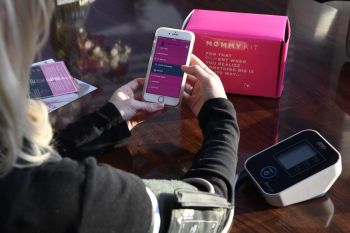
When Briana Teller gave birth, it was one of the best days of her life. Not long after leaving the hospital, however, she developed preeclampsia, a potentially dangerous condition that was quickly diagnosed by her health care providers with help from Babyscripts, an app that provides moms-to-be with educational materials and blood pressure monitoring.
“Without Babyscripts, I may not have realized I was having serious issues and delayed getting the care I needed. [Babyscripts] potentially saved my life,” she says.
Teller used the app, developed with the help of physicians at The George Washington University Medical Faculty Associates (GW MFA), to monitor her blood pressure during her pregnancy and after birth. Thanks to the app’s alarm system, her health providers were alerted to the abnormal blood pressure readings, a sign of preeclampsia, and were able to get her the treatment she needed.
Babyscripts was invented in 2014 after the startup’s developers and Andrew Meltzer, MD, associate professor of emergency medicine at the GW School of Medicine and Health Sciences (SMHS) and current chief medical information officer for the company, saw the potential for an app to help pregnant women manage their health. It’s currently used at more than 50 health systems and institutions across the country.
To ensure the tool would meet the needs of patients and physicians, Meltzer sought help from GW MFA colleagues, including Obstetrics and Gynecology Department Chair Nancy Gaba, MD ’93, RESD ’97, Oscar I. and Mildred S. Dodek and Joan B. and Oscar I. Dodek Jr. Professor of Obstetrics and Gynecology, and Kathryn Marko, MD, assistant professor of obstetrics and gynecology at SMHS.
“We helped to structure the app regarding what information and resources it was going to offer and what features it would have,” Marko says. “It’s unique because there are a lot of inaccurate apps out there, and this one ensures patients are getting educational materials straight from their doctors.”
Babyscripts can help to reduce in-person visits at the OB-GYN during pregnancy, Marko adds. A number of visits consist of providing education materials and taking blood pressure — both things that can be done through the app. These findings were published by Marko and Meltzer in the journal JMIR mHealth and uHealth last year.
In addition, when COVID-19 arrived in the D.C. area and forced many people to forgo routine medical checkups, Babyscripts allowed expectant mothers to remain at home while still having their health monitored.
The GW MFA also is using the app’s educational features to push out information on COVID-19 visitor policies for patients who still need to see a physician, as well as labor and delivery updates, adds Marko.
While providers may be hesitant to form partnerships with tech companies, Meltzer notes how important those relationships can be. “A tech person may have a great idea, but if they don’t work with people in the medical space, they can’t move forward,” he says. “There needs to be an understanding of the workflow of physicians and the needs of doctors and patients.”
“We’re really starting to make strides in using technology in this way, and it’s just the tip of the iceberg,” Marko adds. “It makes medicine exciting and is something the patients love and will really help them.”



